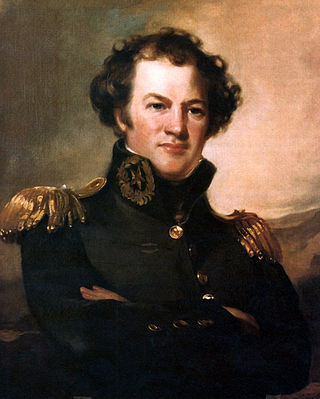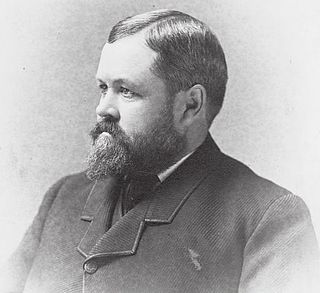
Daniel D. Tompkins was an American politician. He was the fifth governor of New York from 1807 to 1817, and the sixth vice president of the United States from 1817 to 1825.

The Battle of Plattsburgh, also known as the Battle of Lake Champlain, ended the final British invasion of the northern states of the United States during the War of 1812. Two British forces, an army under Lieutenant General Sir George Prévost and a naval squadron under Captain George Downie converged on the lakeside town of Plattsburgh, New York. Plattsburgh was defended by New York and Vermont militia and detachments of regular troops of the United States Army, all under the command of Brigadier General Alexander Macomb, and ships commanded by Master Commandant Thomas Macdonough.

Plattsburgh is a city in, and the seat of, Clinton County, New York, United States, situated on the north-western shore of Lake Champlain. The population was 19,841 at the 2020 census. The population of the surrounding Town of Plattsburgh was 11,886 as of the 2020 census, making the combined population for all of greater Plattsburgh to be 31,727. Plattsburgh lies just to the northeast of Adirondack Park, immediately outside of the park boundaries. It is the second largest community in the North Country region, and serves as the main commercial hub for the sparsely populated northern Adirondack Mountains. The land around what is referred to as Plattsburgh was previously inhabited by the Iroquois, Western Abenaki, Mohican and Mohawk people. Samuel de Champlain was the first ever recorded European that sailed into Champlain Valley and later claimed the region as a part of New France in 1609.
Fort Hamilton is a United States Army installation in the southwestern corner of the New York City borough of Brooklyn, surrounded by the communities of Bay Ridge and Dyker Heights. It is one of several posts that are part of the region which is headquartered by the Military District of Washington. Its mission is to provide the New York metropolitan area with military installation support for the Army National Guard and the United States Army Reserve. The original fort was completed in 1831, with major additions made in the 1870s and 1900s. However, all defenses except about half of the original fort have been demolished or buried.

The Second Battle of Sacket's Harbor or simply the Battle of Sacket's Harbor, took place on 29 May 1813, during the War of 1812. A British force was transported across Lake Ontario and attempted to capture the town, which was the principal dockyard and base for the American naval squadron on the lake. Twelve warships were built here. The British were repulsed by American regulars, militia, marines and sailors.

Fort Wadsworth is a former United States military installation on Staten Island in New York City, situated on The Narrows which divide New York Bay into Upper and Lower halves, a natural point for defense of the Upper Bay and Manhattan beyond. Prior to closing in 1994 it claimed to be the longest continually garrisoned military installation in the United States. It comprises several fortifications, including Fort Tompkins and Battery Weed and was given its present name in 1865 to honor Brigadier General James Wadsworth, who had been killed in the Battle of the Wilderness during the Civil War. Fort Wadsworth is now part of the Staten Island Unit of Gateway National Recreation Area, maintained by the National Park Service.

Alexander Macomb was the Commanding General of the United States Army from May 29, 1828, until his death on June 25, 1841. Macomb was the field commander at the Battle of Plattsburgh during the War of 1812 and, after the stunning victory, was lauded with praise and styled "The Hero of Plattsburgh" by some of the American press. He was promoted to Major General for his conduct, receiving both the Thanks of Congress and a Congressional Gold Medal.

Plattsburgh International Airport is a county public-use airport located three nautical miles (6 km) south of the central business district of the city of Plattsburgh, within the Town of Plattsburgh in Clinton County, New York, United States. About 85 percent of the airport's passengers in 2013 were Canadians, mostly from Montreal.

The following is a synopsis of the land campaigns of the War of 1812.

Plattsburgh Air Force Base is a former United States Air Force (USAF) Strategic Air Command (SAC) base covering 3,447 acres (13.7 km²) in the extreme northeast corner of New York, located on the western shore of Lake Champlain opposite Burlington, Vermont, in the city of Plattsburgh, New York.
Citizens' Military Training Camps (CMTC) were military training programs of the United States. Held annually each summer during the years 1921 to 1940, the CMTC camps differed from National Guard and Organized Reserve training in that the program allowed male citizens to obtain basic military training without an obligation to call-up for active duty. The CMTC were authorized by the National Defense Act of 1920 as a compromise that rejected universal military training. In its nearly two decades of operation, the CMTC trained some 400,000 men in at least one season from 1921 to 1940. Overall the program was disappointing, as only 5,000 officer commissions were awarded to men who completed the required four summers of training.
Fort Tompkins may refer to any of several War of 1812 forts named for Governor Daniel D. Tompkins of New York State:

John Henry Moffitt was a United States representative from New York and the recipient of the Medal of Honor for his actions during the Civil War.

Plattsburgh Bay, also known as Cumberland Bay, is an inlet on the western shore of Lake Champlain in Clinton County, New York. The bay is the location of the town and city of Plattsburgh, and was the site of the Battle of Plattsburgh, a naval and land engagement fought on September 11, 1814, late in the War of 1812. The bay and two land sites related to the battle were designated as a National Historic Landmark in 1960.

Battery Weed is a four-tiered 19th century fortification guarding the Narrows, the main approach from the Atlantic Ocean to New York City. Located on the Staten Island waterfront on the west shore of the Narrows, directly across from Fort Hamilton and the now-destroyed Fort Lafayette in Brooklyn, the fort was intended to protect New York from attack by sea. When built, it was named Fort Richmond, as was a previous fort on the site.

Fort Tompkins is a fort on Staten Island in New York City, within what is now Fort Wadsworth at the Narrows. Fort Tompkins guarded the landward approaches to other forts in the area from 1808 through circa 1898. The current fort was built 1847–1861, and was operational as a fort until superseded by new defenses circa 1898. It is now part of the Gateway National Recreation Area. It is the last remaining of four forts in New York State named Fort Tompkins.

The "Old Stone Barracks" is the last remaining structure of a proposed quadrangle of early U.S. Army barracks built at Plattsburgh, New York in 1838. Of the four main buildings initially planned for the Plattsburgh post, only two were ever constructed, an officer's barracks and an enlisted barracks which formed an "L" shape. The buildings were utilized by the Army for nearly a century. The officer's quarters, in which Lt. Ulysses S. Grant once stayed, was torn down by the U.S. Air Force during the winter of 1963. The remaining building, the 200-foot (61 m) long, two story "Old Stone Barracks," remained mostly empty after the early 1960s and was added to the National Register of Historic Places in 1971. In December 2010 the Barracks and more than 7 acres of property was offered to a Canadian real estate developer for $35,000 with the intention of building an apartment complex on the historic site. At the time, the Barracks property was appraised at over $775,000 and the sale sparked public outcry for its preservation. In 2014, the building was again sold to current owners Terry Schmaltz and Mary Theresa Pearl who redeveloped it as the home of the "Valcour Brewing Company." The new craft brewery opened in 2016.

Charles Henry Tompkins was an American officer who served as a Union Army colonel, who received an appointment to the brevet grade of Brigadier General of volunteers during the American Civil War. He was a recipient of the Medal of Honor for valor in action on June 1, 1861, in the Battle of Fairfax Court House. This was the first action in the Civil War for which a Union Army officer would receive the Medal of Honor, although it was not awarded until 1893. He is not to be confused with another Union officer, Brevet Brigadier General Charles H. Tompkins who commanded the 1st Rhode Island Light Artillery Regiment.
Fort Brown Site is a historic former redoubt located on the Saranac River at Plattsburgh in Clinton County, New York. It was built during the War of 1812 and used in Battle of Plattsburgh. It had eight guns and four interior buildings.